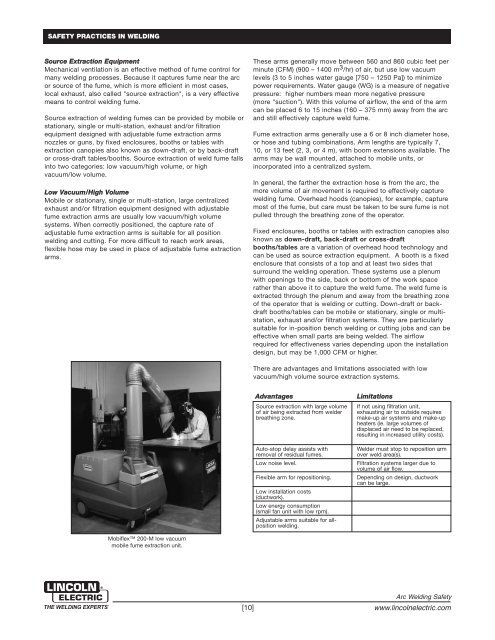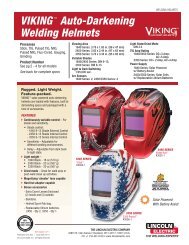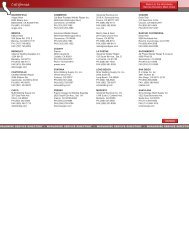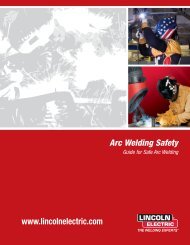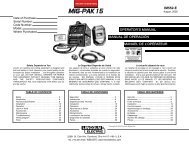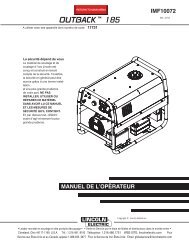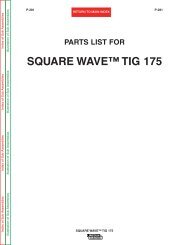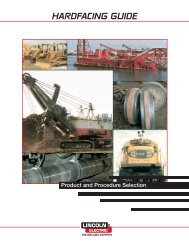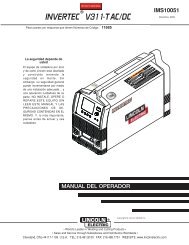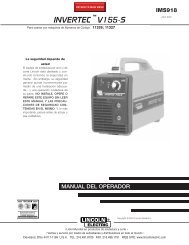E205 Arc Welding Safety - Lincoln Electric
E205 Arc Welding Safety - Lincoln Electric
E205 Arc Welding Safety - Lincoln Electric
You also want an ePaper? Increase the reach of your titles
YUMPU automatically turns print PDFs into web optimized ePapers that Google loves.
SAFETY PRACTICES IN WELDING<br />
Source Extraction Equipment<br />
Mechanical ventilation is an effective method of fume control for<br />
many welding processes. Because it captures fume near the arc<br />
or source of the fume, which is more efficient in most cases,<br />
local exhaust, also called "source extraction", is a very effective<br />
means to control welding fume.<br />
Source extraction of welding fumes can be provided by mobile or<br />
stationary, single or multi-station, exhaust and/or filtration<br />
equipment designed with adjustable fume extraction arms<br />
nozzles or guns, by fixed enclosures, booths or tables with<br />
extraction canopies also known as down-draft, or by back-draft<br />
or cross-draft tables/booths. Source extraction of weld fume falls<br />
into two categories: low vacuum/high volume, or high<br />
vacuum/low volume.<br />
Low Vacuum/High Volume<br />
Mobile or stationary, single or multi-station, large centralized<br />
exhaust and/or filtration equipment designed with adjustable<br />
fume extraction arms are usually low vacuum/high volume<br />
systems. When correctly positioned, the capture rate of<br />
adjustable fume extraction arms is suitable for all position<br />
welding and cutting. For more difficult to reach work areas,<br />
flexible hose may be used in place of adjustable fume extraction<br />
arms.<br />
Mobiflex 200-M low vacuum<br />
mobile fume extraction unit.<br />
[10]<br />
These arms generally move between 560 and 860 cubic feet per<br />
minute (CFM) (900 – 1400 m 3 /hr) of air, but use low vacuum<br />
levels (3 to 5 inches water gauge [750 – 1250 Pa]) to minimize<br />
power requirements. Water gauge (WG) is a measure of negative<br />
pressure: higher numbers mean more negative pressure<br />
(more "suction"). With this volume of airflow, the end of the arm<br />
can be placed 6 to 15 inches (160 – 375 mm) away from the arc<br />
and still effectively capture weld fume.<br />
Fume extraction arms generally use a 6 or 8 inch diameter hose,<br />
or hose and tubing combinations. Arm lengths are typically 7,<br />
10, or 13 feet (2, 3, or 4 m), with boom extensions available. The<br />
arms may be wall mounted, attached to mobile units, or<br />
incorporated into a centralized system.<br />
In general, the farther the extraction hose is from the arc, the<br />
more volume of air movement is required to effectively capture<br />
welding fume. Overhead hoods (canopies), for example, capture<br />
most of the fume, but care must be taken to be sure fume is not<br />
pulled through the breathing zone of the operator.<br />
Fixed enclosures, booths or tables with extraction canopies also<br />
known as down-draft, back-draft or cross-draft<br />
booths/tables are a variation of overhead hood technology and<br />
can be used as source extraction equipment. A booth is a fixed<br />
enclosure that consists of a top and at least two sides that<br />
surround the welding operation. These systems use a plenum<br />
with openings to the side, back or bottom of the work space<br />
rather than above it to capture the weld fume. The weld fume is<br />
extracted through the plenum and away from the breathing zone<br />
of the operator that is welding or cutting. Down-draft or backdraft<br />
booths/tables can be mobile or stationary, single or multistation,<br />
exhaust and/or filtration systems. They are particularly<br />
suitable for in-position bench welding or cutting jobs and can be<br />
effective when small parts are being welded. The airflow<br />
required for effectiveness varies depending upon the installation<br />
design, but may be 1,000 CFM or higher.<br />
There are advantages and limitations associated with low<br />
vacuum/high volume source extraction systems.<br />
Advantages Limitations<br />
Source extraction with large volume<br />
of air being extracted from welder<br />
breathing zone.<br />
Auto-stop delay assists with<br />
removal of residual fumes.<br />
Low noise level.<br />
Flexible arm for repositioning.<br />
Low installation costs<br />
(ductwork).<br />
Low energy consumption<br />
(small fan unit with low rpm).<br />
Adjustable arms suitable for allposition<br />
welding.<br />
If not using filtration unit,<br />
exhausting air to outside requires<br />
make-up air systems and make-up<br />
heaters (ie. large volumes of<br />
displaced air need to be replaced,<br />
resulting in increased utility costs).<br />
Welder must stop to reposition arm<br />
over weld area(s).<br />
Filtration systems larger due to<br />
volume of air flow.<br />
Depending on design, ductwork<br />
can be large.<br />
<strong>Arc</strong> <strong>Welding</strong> <strong>Safety</strong><br />
www.lincolnelectric.com


